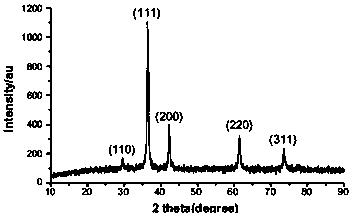Application of cuprous oxide nanoparticles for preparing drug for treating bladder cancer
A technology of cuprous oxide and chemotherapeutic drugs, applied in the field of medicine, can solve the problems of unsatisfactory response rate, toxic side effects, and allergic reactions of bladder cancer antitumor drugs, achieve good clinical application prospects, reduce side effects, and reduce recurrence rates
- Summary
- Abstract
- Description
- Claims
- Application Information
AI Technical Summary
Problems solved by technology
Method used
Image
Examples
Embodiment 1
[0034] Example 1: In vitro anti-proliferation experiment of cuprous oxide against bladder cancer cells
[0035] The bladder tumor cell lines 5637 and T24 used in the research were provided by the Urology Laboratory of Changhai Hospital, Second Military Medical University, and were purchased from the Cell Bank of Shanghai Academy of Biological Sciences, Chinese Academy of Sciences.
[0036] (1) Microscopic observation of the cells to be treated: human bladder urothelial cancer cells T24, J82, 5637, SW-780 human normal urothelial cells SVHUC-1; cells in logarithmic growth phase and in good condition were selected and subjected to the above method. Trypsinize, centrifuge to retain the cell pellet, and resuspend into a single cell suspension. After counting by a cell counter, dilute the cell suspension with serum-containing medium to adjust the final cell concentration to 2.5×104 cells / mL.
[0037] (2) Take a 96-well plate, mark it according to the predetermined concentration grad...
Embodiment 2
[0042] Example 2: Cuprous oxide nanoparticles induce cycle arrest in bladder cancer cells
[0043] (1) Select bladder urothelial carcinoma T24 and 5637 cell lines as the research objects, digest, centrifuge and count as above, and dilute the cell concentration to 5×104 cells / mL.
[0044] (2) Take 2mL of cell suspension and add it to each duplicate well of a 6-well plate. The cells are evenly distributed by the figure-eight shaking method. Incubate in a carbon dioxide cell incubator for 6-8 hours until the cells adhere to the wall.
[0045] (3) Observe that the cells in the multiple wells are well adhered to the wall, discard the old medium, and add cuprous oxide nanoparticles-1640 medium with a concentration of 1.25 μg / mL, 2.5 μg / mL, and 5 μg / mL respectively, and add to the blank control group The 1640 medium without cuprous oxide nanoparticles was cultivated in the incubator for 48 hours.
[0046] (4) Digest with trypsin according to the above method and collect the cell pel...
Embodiment 3
[0049] Example 3: Cuprous oxide nanoparticles induce apoptosis of bladder cancer cells
[0050] (1) Select bladder urothelial carcinoma T24 and 5637 cell lines as the research objects, digest, centrifuge and count as above, and dilute the cell concentration to 5×104 cells / mL.
[0051] (2) Pipette 2mL of cell suspension into each duplicate well of the 6-well plate, shake the cells evenly, and incubate in the carbon dioxide cell incubator for 6-8 hours until the cells adhere to the wall.
[0052] (3) Observe that the cells in the multiple wells are well adhered to the wall, discard the old medium, and add cuprous oxide nanoparticles-1640 medium with a concentration of 1.25 μg / mL, 2.5 μg / mL, and 5 μg / mL respectively, and add to the blank control group The 1640 medium without cuprous oxide nanoparticles was cultivated in the incubator for 48 hours.
[0053] (4) Digest with trypsin according to the above method and collect the cell pellets of each duplicate well, add an appropriat...
PUM
 Login to View More
Login to View More Abstract
Description
Claims
Application Information
 Login to View More
Login to View More - R&D Engineer
- R&D Manager
- IP Professional
- Industry Leading Data Capabilities
- Powerful AI technology
- Patent DNA Extraction
Browse by: Latest US Patents, China's latest patents, Technical Efficacy Thesaurus, Application Domain, Technology Topic, Popular Technical Reports.
© 2024 PatSnap. All rights reserved.Legal|Privacy policy|Modern Slavery Act Transparency Statement|Sitemap|About US| Contact US: help@patsnap.com










